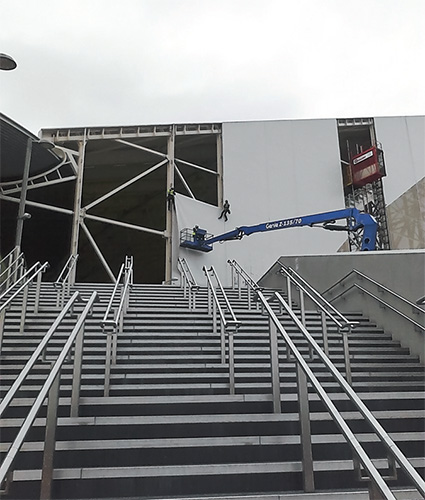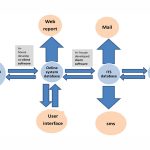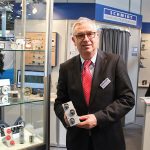VinyLoop – A Process

VinyLoop is the only process that allows PVC scraps to be recycled, resulting in an R-PVC compound that has the same properties as the virgin one – originally used to manufacture products before their “end of life.” A process capable of ensuring such high levels of purity has to be based on selective dissolution of the PVC content in the scraps, followed by filtration of the remaining undissolved impurities and finally precipitation of the dissolved PVC to obtain new compounds.
The VinyLoop process can recycle virtually all kinds of PVC scraps, as long as they do not contain materials such as silicium carbide – something that can damage the plant – and provided that the PVC content is higher than a certain threshold (approximately 65 per cent).
A VinyLoop plant is currently in operation at Ferrara, Italy, producing high quality R-PVC mainly from cable scraps.
VinyLoop: A Short History
At the end of the twentieth century, Solvay, a world leader in PVC manufacturing, and Serge Ferrari, a French company specialising in high-technology textiles, joined hands to develop a new concept of recycling. The basic objective was to develop a new process that could add as much value as possible to the recycled material. This involved, on the input side, the treatment of low-value post-consumer scraps and, on the output side, the achievement of a high-quality, virgin-like final product. This approach reflected a strong commitment to environmental responsibility – on the one hand, post-consumer scrap is usually at the end of its life and consequently destined for landfill or incineration; and on the other hand, a widespread use of recycled products directly depends on the final consumer’s awareness of the physical and mechanical performance of R-PVC products.
The Ferrara plant started its operation in spring 2002, and the difficulties in developing and tuning the process were immediately clear. To put it briefly, it has been not easy to tighten the large specifications of the raw material to the narrow ones required for high-quality, consistent R-PVC.
We, therefore, started with a number of plant improvements that allowed us to achieve full control of the process. These included, in particular, the installation of a pre-treatment step; the fine tuning of the filtration step; the addition of a new line, in addition to the one dedicated to cable scraps, to treat fibre-containing scrap; and the addition of the final step to purify the solvent-PVC solution (Centrifugal Decanter).
After perfecting improvement actions, we are able to fully control the process and are taking advantage of the new opportunities, namely new feed stocks never tested before.
Cables Scrap Recycling



VinyLoop was originally developed to treat cable scraps, and this type of feedstock is still by far the most important. Over 12 years of operation, we have recycled an estimated 70 kt of cable scraps (the yearly average is currently approx. 8 kt). The main steps of the process are as follows. First, cable scraps are processed in a pre-treatment unit to separate and recover the residual copper still included in the scraps (that we can sell as recycled copper). Next, the scraps enter the dissolution unit, where only the PVC and all the additives originally included in the compound are dissolved. In the next step, (primary filter) solid impurities (polyolefins, rubber, textiles, etc.) are separated; then the solution is sent to the Centrifugal Decanter for complete purification. The Centrifugal Decanter is the best available technique to eliminate the final contaminants from a solution on an industrial scale. This device, a worldwide prototype, applies a huge centrifugal force to the remaining solid particles, clarifying the solution from residual contaminants and removing part of mineral fillers used in the original formulation of the compound.
The final product typically has the features shown in Table 1.
VinyLoop R-PVC is sold for several final applications: membranes, garden hoses, splashguards, shoes, soles, etc.; importantly, the quality level ensured by the purity of the compound allows membrane sheets to be welded without tearing problems.
Environmental Added Value
A key element of the VinyLoop approach consists in measuring the environmental advantages involved in the use of R-PVC by means of the Life Cycle Assessment (LCA) methodology. We initially conducted a study to measure the advantages of manufacturing a VinyLoop R-PVC compound, compared to manufacturing a virgin compound. The results of this study, certified by a third party (DEKRA), show a significantly lower environmental impact.
In particular:
Global Warming: -40%
Energy Demand: -47%
Water Consumption: -76%
Subsequently, we widened the scope of LCA to products manufactured by our customers, so as to characterise their environmental quality and provide suggestions for their promotion focusing on their high sustainability.
For example, one of our customers, a manufacturer of garden hoses, is now able to label its products with accurate information on the environmental benefits ensured by the use of R-PVC, offering added value to its customers.
It should also be noted that the London Olympic Committee encouraged the use of recyclable materials, both in support of environmental sustainability principles and to allow facilities and equipment to be sized down at the end of the Games, eliminating the parts that were no longer needed. The roofings of three Olympic Stadiums were made in PVC; after the Games, they were partly dismantled and recycled at our Ferrara VinyLoop plant.
As it represents an example of the plastic industry’s commitment to sustainable growth, our Ferrara VinyLoop plant is regularly visited by representatives of professional associations, public authorities, universities and schools.
Licensing
The VinyLoop process is characterised by a high level of technological innovation, which is proved by the high number of patents filed over the years. A recent evolution of our strategy is the decision to promote licensing to third parties for the construction of new plants using the VinyLoop technology. The willingness to share our intellectual property and the expertise acquired over the years shows our commitment to promoting a widespread use of an innovative technology supporting sustainability and the growth of recycling.
Reflecting this approach, we have developed a proposal consisting in a preliminary exchange of information with investors who may be interested in the use of the VinyLoop technology; this exchange of information is normally accompanied by the signature of a Non Disclosure Agreement to ensure the confidentiality of the information provided.
After making sure investors are willing to proceed, we make ourselves available for the conduct of laboratory tests at our Brussels Research Centre, followed by an industrial test at our Ferrara plant. Once the preliminary tests are completed, we offer our experience to make the first economic assessment of the proposed new plant to be constructed.
Conclusion
After 12 years of operation, VinyLoop has proved to be a high-performance recycling process that is flexible enough to fit a wide range of PVC scraps.
The high performance of the resulting product widens the applications of recycled PVC, and the accompanying assessment of environmental value by means of suitable methods widens its attractiveness, meeting the growing needs of consumers who demand environmentally-responsible solutions.
Our availability to licence the construction of new plants, coupled with the advice we can offer for the development ofa preliminary project, will allow this breakthrough technology to be applied worldwide. n
This article has been written by Mr. Paolo Groppi, General Manager, VinyLoop






